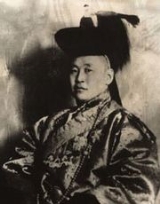
Shirindambyn Namnansüren
Encyclopedia
Tögs-Ochiryn Namnansüren , with full title Sain Noyon Khan Namnansüren ' onMouseout='HidePop("9160")' href="/topics/Noyan">noyon
khan
Namnansuren), was a powerful hereditary prince who also served as prime minister of Autonomous Mongolia from 1912 to 1915 in the government of the Bogd Khan
. In 1915 the office of prime minister was abolished and Namnansüren was appointed minister of the army.
In 1912, Namnansüren, who allegedly could trace his heritage directly back to Genghis Khan
, was appointed prime minister of Autonomous Mongolia under the recently installed Bogd Khan as a result of infighting between various ministries and the Buddhist clergy as to which group held more prestige.
Attempts by Namnansüren to contact ambassadors from several western countries (United States, Great Britain, France and Germany) and to organize a trip to Western Europe to gain international support for Mongolia’s independence we hindered by Russian officials.
In June 1918, facing increased threats from the Chinese who were demanding Mongolia renounce its Pan-Mongolia ambitions and sign a decree “voluntarily” relinquishing autonomy, Namnansüren again traveled to Russia, this time to Irkutsk, to seek Russian assistance. There he met with two Bolshevik officials in what is believed to be the first meeting between Soviet and Outer Mongolian officials. The Bolsheviks, pre-occupied with the revolution and the ongoing civil war in Russia, did not offer much assistance.
Not long after his return home, Namnansüren fell seriously ill and died sometime in April 1919. Many suspect he was assassinated (poisoned, and others believe he had committed suicide, along with many others involved in the revival of Mongolia’s independence who died premature deaths. Shortly thereafter the Chinese warlord Xu Shuzheng occupied Niislel Khüree and installed Gonchigjalzangiin Badamdorj, who represented reactionary lamas and was more pliable to Chinese demands, as Premier.
In 1914 the Mongolian Namnansüren is known to have brought some films from Russia to show at the residence of the Bogd Khan. These are the first known film showings in Mongolia.
Noyan
Noyan, noyon was a title of authority in the Mongol Empire and later periods...
khan
Khan (title)
Khan is an originally Altaic and subsequently Central Asian title for a sovereign or military ruler, widely used by medieval nomadic Turko-Mongol tribes living to the north of China. 'Khan' is also seen as a title in the Xianbei confederation for their chief between 283 and 289...
Namnansuren), was a powerful hereditary prince who also served as prime minister of Autonomous Mongolia from 1912 to 1915 in the government of the Bogd Khan
Bogd Khan
The Bogd Khan was enthroned as the Great Khaan of Mongolia on 29 December 1911, when Outer Mongolia declared independence from the Qing Dynasty after the Xinhai Revolution. He was born in the Kham region of eastern Tibet, today's Sichuan province of the People's Republic of China...
. In 1915 the office of prime minister was abolished and Namnansüren was appointed minister of the army.
Prime minister
In July 1911 Namnansüren was a member of the delegation sent by the Bogd Gegeen to St. Petersburg to seek the support of Russia and West European countries for Mongolian independence.In 1912, Namnansüren, who allegedly could trace his heritage directly back to Genghis Khan
Genghis Khan
Genghis Khan , born Temujin and occasionally known by his temple name Taizu , was the founder and Great Khan of the Mongol Empire, which became the largest contiguous empire in history after his death....
, was appointed prime minister of Autonomous Mongolia under the recently installed Bogd Khan as a result of infighting between various ministries and the Buddhist clergy as to which group held more prestige.
Kyakhta Treaty Negotiations
From November 1913 to January 1914 Namnansüren lead another delegation to St. Petersburg, this time to guard Mongolian interests during Kyakhta treaty conference, bilateral negotiations between Russia and China that would define the border between Russian Siberia and the Qing territories of Mongolia and Manchuria. Ultimately Mongolian hopes for international recognition of its independence and support for a union between Inner and Outer Mongolia were dashed when the agreement re-confirmed the country’s status as an autonomous region within China.Attempts by Namnansüren to contact ambassadors from several western countries (United States, Great Britain, France and Germany) and to organize a trip to Western Europe to gain international support for Mongolia’s independence we hindered by Russian officials.
In June 1918, facing increased threats from the Chinese who were demanding Mongolia renounce its Pan-Mongolia ambitions and sign a decree “voluntarily” relinquishing autonomy, Namnansüren again traveled to Russia, this time to Irkutsk, to seek Russian assistance. There he met with two Bolshevik officials in what is believed to be the first meeting between Soviet and Outer Mongolian officials. The Bolsheviks, pre-occupied with the revolution and the ongoing civil war in Russia, did not offer much assistance.
Death
Not long after his return home, Namnansüren fell seriously ill and died sometime in April 1919. Many suspect he was assassinated (poisoned, and others believe he had committed suicide, along with many others involved in the revival of Mongolia’s independence who died premature deaths. Shortly thereafter the Chinese warlord Xu Shuzheng occupied Niislel Khüree and installed Gonchigjalzangiin Badamdorj, who represented reactionary lamas and was more pliable to Chinese demands, as Premier.
In 1914 the Mongolian Namnansüren is known to have brought some films from Russia to show at the residence of the Bogd Khan. These are the first known film showings in Mongolia.

